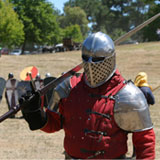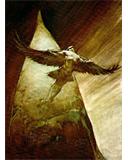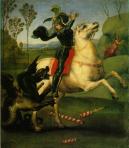 |
|
|
|
| Author |
Message |
mikronn
Location: Plimmerton
|
 Posted: Tue Sep 04, 2012 6:29 pm The bind Posted: Tue Sep 04, 2012 6:29 pm The bind |
 |
|
Hi John and Jim
John - keep up the good work, looking forward to seeing the product in September.
As to the bind - Colin (McKinstry) keeps drilling it with us and punishes us whenever we disengage.
As Jim says, its the really fun part where the mastery somes to the fore. I'm definitely still in learning mode
cheers
mike |
|
|
 |
Freebooter
Principal Sponsor

Location: Hamilton
|
 Posted: Tue Sep 04, 2012 7:02 pm Posted: Tue Sep 04, 2012 7:02 pm |
 |
|
A disengagement out of bind is a valid technique so long as you reclaim control of the opposing weapon immediately after disengagement.
Failure to do this tends to result in perforation.
Keep up the good work, JohnF. |
|
|
 |
JohnF

Location: Palmy
|
 Posted: Tue Sep 04, 2012 7:26 pm Posted: Tue Sep 04, 2012 7:26 pm |
 |
|
And we so dislike perforation  . .
Good point on changing the sword, Freebooter. Also recommended in the I.33. |
|
|
 |
Mad Jim

Location: Dunedin
|
 Posted: Tue Sep 04, 2012 8:17 pm Posted: Tue Sep 04, 2012 8:17 pm |
 |
|
On changing, Swiss Master Hugue Wittenwiller (circa late 1400's) talks alot about striking at the sword and changing in uppers and lowers, which in some works talks about should he always go for the sword; do this or this, in Hugues case I feel its more either parrying the incoming blow and changing/winding or as he talks a fair amount of treading rearward, voiding the blow and parry or beating the sword and stepping forth with a changer and thrusting through.
Or he advises to beat or attack the sword, disingage and strike around to the other side, then slipping into a low or high ward with the changer.
Though as he uses the term 'Wechsel' (changer) as a mutible meaning, I gather some are muterien, changing, changing through, winds etc.
Anyway has something to do with binds and disengaging!
Also his fechtbuch CM558 (I think) is based on more battlefield fighting..
_________________
I like living.. |
|
|
 |
JohnF

Location: Palmy
|
 Posted: Tue Sep 04, 2012 8:42 pm Posted: Tue Sep 04, 2012 8:42 pm |
 |
|
The term used in I.33 is mutatio gladij. In addition to the scenarios above I believe the I.33 recommends it when the overbinder binds too strongly, giving such momentum to the patients sword that it is better to change the sword than to stay in the bind. E.g.

Looking forward top catching up in a couple of weeks and learning how to apply all these theories bouncing around in my head  . . |
|
|
 |
Mad Jim

Location: Dunedin
|
 Posted: Tue Sep 04, 2012 9:18 pm Posted: Tue Sep 04, 2012 9:18 pm |
 |
|
Yes in most of the German fechtbuchs on longsword, they use the term Mutieren or to mutate/transform which is working from the bind, I think when they are weak, by going up with arms (your strong on their weak) and hanging your blade/point over their blade and stabbing at the lower opening, though if they are strong in the bind and forcing your blade you use their momentum and snap (schappen) your blade, though it almost slides out and strike to the head, or I think with the change through stab/thrust to the face. Or if they are strong but not forcing your blade you go up with the arms at their weak, and thrust to the face/chest.
I find showing new people that they when have bound push hard at the sword, thinking you will do the same, hollywood style, but then they are rather suprised when you let your sword go with it and bring down on their head.
I have a copy of the I:33 with English trans that I put together and printed out, but I have pretty much spent the last couple of years learning and reseaching the longsword, so set the S&B aside. So hopefully in 5 years time I should be ok with the longsword...that would be 8.5 years of trying to get better!!
_________________
I like living.. |
|
|
 |
JohnF

Location: Palmy
|
 Posted: Wed Sep 05, 2012 12:51 pm Posted: Wed Sep 05, 2012 12:51 pm |
 |
|
Ach! I know the feeling, I've got a book on Paulus Hector Mair's Polearms, I've flicked through the pages... but to study it would be at the expense of S&B.
Question time. For anyone. Would you say that the Priest is doing a Shield Strike, as opposed to a Thrust Strike, in Folio 7r, bottom picture?
 |
|
|
 |
Mad Jim

Location: Dunedin
|
 Posted: Wed Sep 05, 2012 5:32 pm Posted: Wed Sep 05, 2012 5:32 pm |
 |
|
At a guess a shield strike/bind followed by an inverted thrust/strike...in regards to Milkrons reply below, I have also seen the shield knock to bind up your opponents weapon and shield, to which my reply was..above at the start of this post to go around the outside, around the outside (ignore this silly song)
Roland of Hammaborg would give the best explanation I'd say, being a top I:33 researcher and fencer....love to learn from those guys!
_________________
I like living..
Last edited by Mad Jim on Wed Sep 05, 2012 7:52 pm; edited 1 time in total |
|
|
 |
mikronn
Location: Plimmerton
|
 Posted: Wed Sep 05, 2012 7:42 pm Priest move Posted: Wed Sep 05, 2012 7:42 pm Priest move |
 |
|
There is a move that looks like that in the Agilitas DVD, where the buckler is being used to bind out patient's sword and buckler. The move is an inverted (false edge) strike.
If Colin is reading this, I'll defer to his judgment.
cheers
mike |
|
|
 |
JohnF

Location: Palmy
|
 Posted: Wed Sep 05, 2012 8:16 pm Posted: Wed Sep 05, 2012 8:16 pm |
 |
|
What's throwing me is the the text on the page:-
| Quote: | Here the game of the former ward will take place, namely of binder and bound.
Verse:
Binder and bound are contrary and irate,
The bound flees to the side, I try to follow.
|
I'm now thinking it is a Shield Strike, not a Thrust Strike. These are the two terms used in the I.33 to describe similar looking attacks.
I am doubtful that the sword rotates almost 360 degrees to strike with the false. I say this because the same foot is forward, and the binder is the one delivering the attack. Whereas such a large rotation of the sword would be more likely from the bound, as it would make sense for them to flee laterally, which would allow space for the sword to make a large rotation - possibly combined with a change in lead foot.
I suggest that it is a true edge strike simllar to the Thrust Strike to the neck/face shown in the Agiltas DVD after striking the enemies arm. A Thrust Strike being exactly like a thrust, but the edge is thrust into the enemy. Wider area of attack, less likely to miss compared with a regular thrust - at the expense of penetrative power.
Last edited by JohnF on Wed Sep 05, 2012 9:16 pm; edited 2 times in total |
|
|
 |
JohnF

Location: Palmy
|
 Posted: Wed Sep 05, 2012 8:23 pm Posted: Wed Sep 05, 2012 8:23 pm |
 |
|
Got it. Folio 2v has a similar picture.
| Quote: | | Note that the Scholar is here binding and entering, so that he may place a Shield Strike, as below. |

Based on this I'm confident it is a Shield Strike. Probably just me splitting hairs? Yet the I.33 makes the distinction between Thrust Strike and Shield Strike, or stichschlac and schiltslac.
Part of the problem was that I'd tagged two prior images as Thrust Strikes when they should've been Shield Strikes.'
I'll ask Colin on FB to give his opinion on this. |
|
|
 |
Mad Jim

Location: Dunedin
|
 Posted: Wed Sep 05, 2012 10:01 pm Posted: Wed Sep 05, 2012 10:01 pm |
 |
|
Just looking through my copy (needs colour all B&W!), and this is just an idea which you proberly already have covered.
on V6 the play from ward 1 starts and is countered with langort, and mentions bind high or low, now what say that,
que R7, the priest strikes from ward 1 is countered with the langort, and either he fients and rolls over the long point striking low, or binds and the other flees, in which the priest follows with the shield strike and striking the face.
Or He binds and mutates or winds and as the other flees he comes forward with a shield strike tying up the shield and sword, thus a quick cut slashing cut to the face?
Like dagger and longsword this without another is really hard to work out the feedback! What we need is a holodeck, or cyborg!
_________________
I like living.. |
|
|
 |
JohnF

Location: Palmy
|
 Posted: Wed Sep 05, 2012 11:25 pm Posted: Wed Sep 05, 2012 11:25 pm |
 |
|
So here are Folios 6v and 7r
 
My current belief is:-
The play shown in the pictures from the bottom set on 6v, shows the result of a high bind. The lower bind is similar to the Falling Under Play. From the high bind, the Priest pushes the Scholar's sword down until it has cleared his leg. Then he replaces his sword with the buckler and traps the Scholar by pressing his buckler against the Scholar's S&B. He then Thrust Strikes the Scholar.
But possibly instead of a Thrust Strike, the attack is a cut. Where the sword rotates through Left Shoulder to cut into the Scholar's head with the false. |
|
|
 |
Colin

Location: Wellington
|
 Posted: Thu Sep 06, 2012 10:03 am Posted: Thu Sep 06, 2012 10:03 am |
 |
|
I'd need to spend a bit more time on the arguments posed before giving a more definite answer.
Anyway as a general rule of thumb the thrust strike/stab-knock the buckler remains with the sword hand. An example of this has been nicely put together by John at Falling under the sword
The shield knock/shield strike involves sword hand and buckler separating (nucken if memory serves me correct on the spelling.) John doesn't have this play up that I can tell...at least yet and for first position.
Thrust strikes are generally the result of getting the initial and superior bind and the shield strikes are the reply to that thrust strike (or the counter to the shield strike by way of change of sword.)
I should be running a sword workshop at NAAMA this year. I can cover I.33 if there is interest.
_________________
The person who writes for fools is always sure of a large audience.
- Arthur Schopenhauer
See http://www.swordsmanship.co.nz/ |
|
|
 |
JohnF

Location: Palmy
|
 Posted: Thu Sep 06, 2012 8:12 pm Posted: Thu Sep 06, 2012 8:12 pm |
 |
|
Thank Colin. That makes sense.
I've got four plays up now. But not the nucken. I've been concentrating on the easy ones. The ones that can be done with static images. Once that's done I'll work on the trickier ones. Although I'm tempted to text place holders, describing the plays. |
|
|
 |
|
|
 Please read the terms of use
Please read the terms of use
 Contact the Site Admin
Contact the Site Admin





